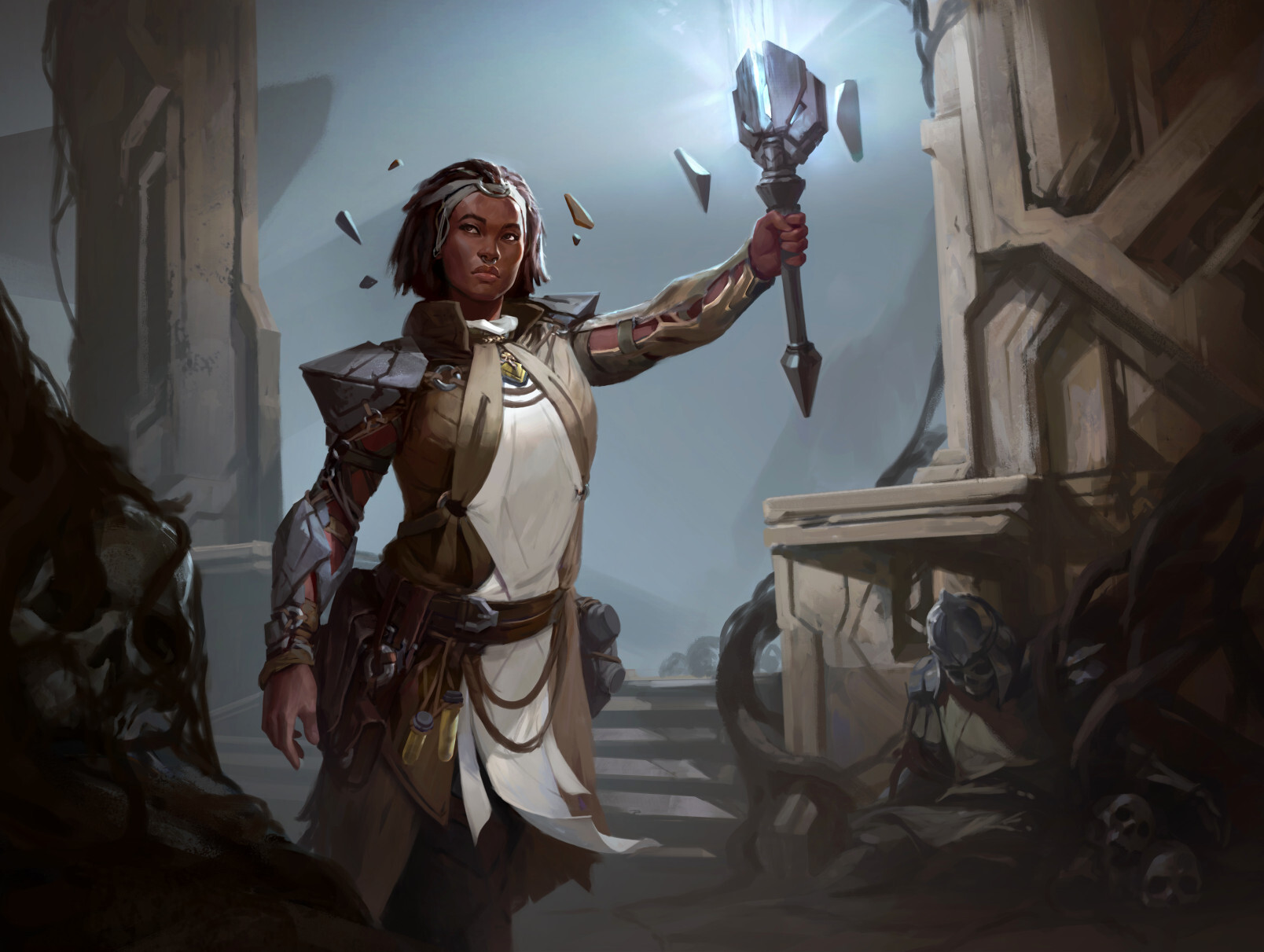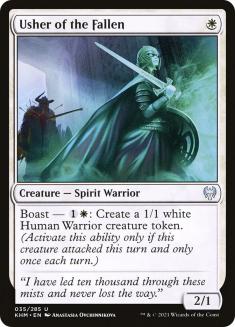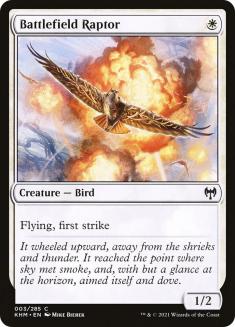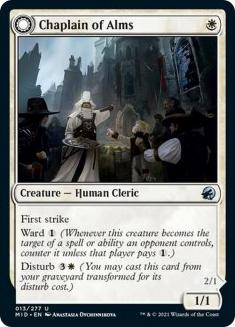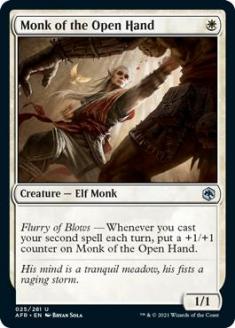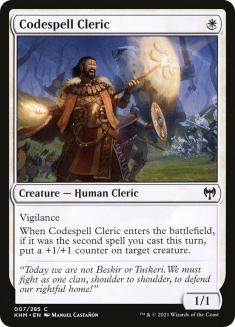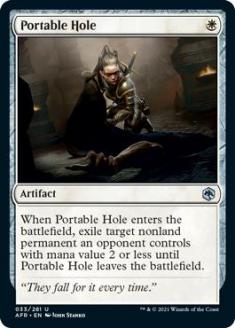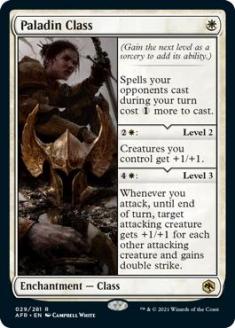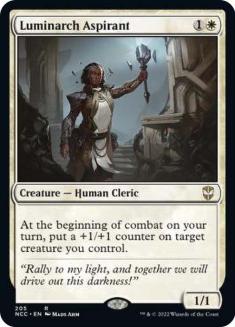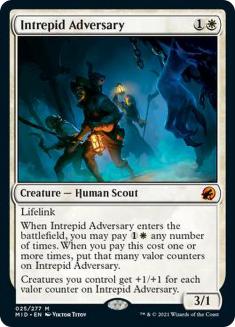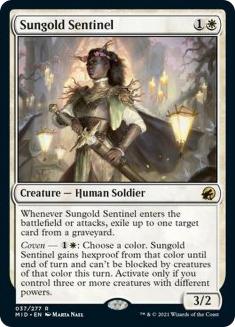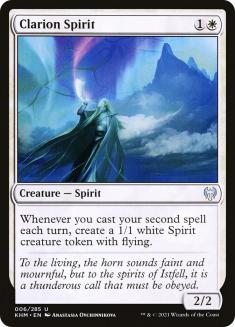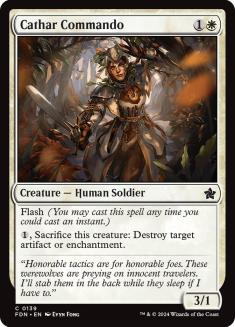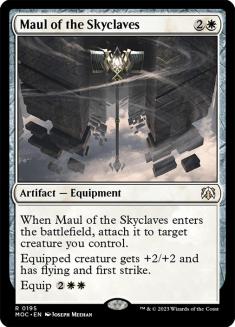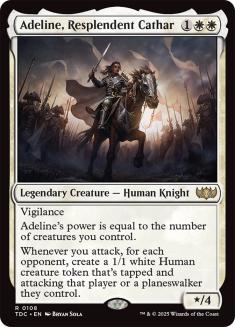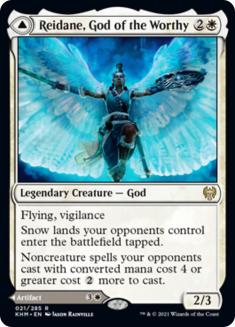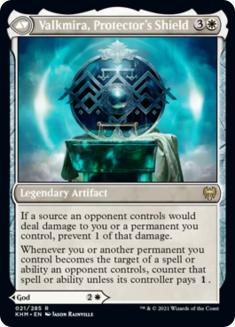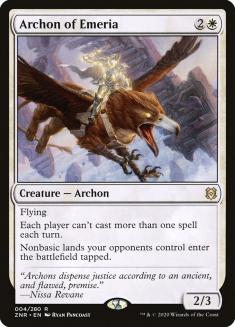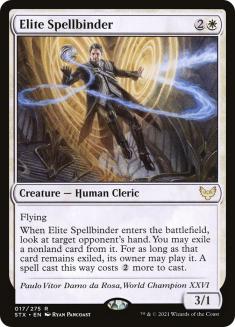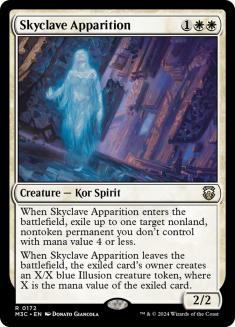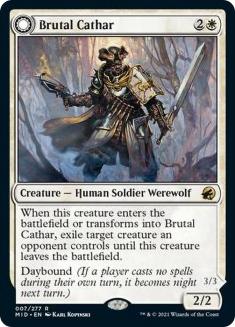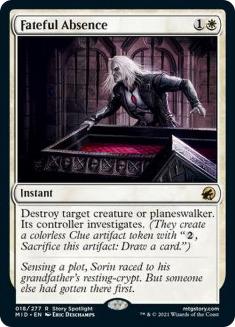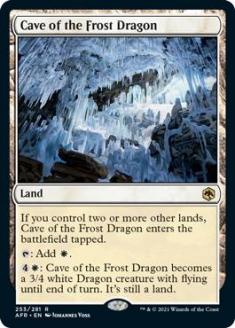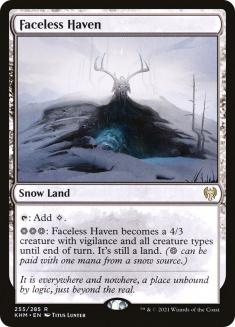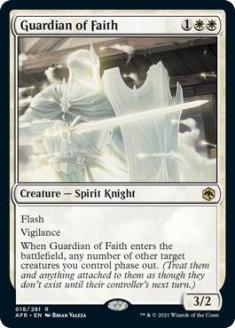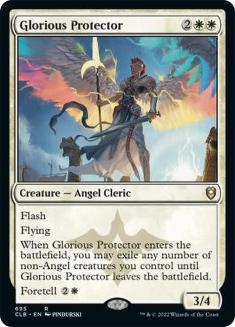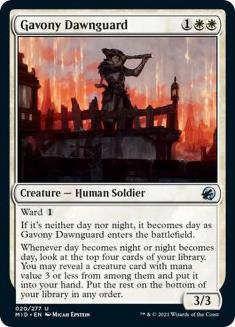Innistrad: Midnight Hunt Standard is the perfect distillation of Magic’s colour pie and the state of metagame analysis in these confusing times. A Mono-Green deck that somehow is the best at everything squares off against a blue deck that is flashy and satisfying but isn’t putting up the numbers. Meanwhile, some brave underdogs are fighting the good fight with small white creatures.
Some of those underdogs are doing remarkably well, though…
Creatures (30)
- 4 Luminarch Aspirant
- 4 Clarion Spirit
- 4 Usher of the Fallen
- 4 Battlefield Raptor
- 2 Elite Spellbinder
- 4 Chaplain of Alms
- 4 Intrepid Adversary
- 4 Adeline, Resplendent Cathar
Lands (23)
Spells (7)

Creatures (31)
- 4 Luminarch Aspirant
- 4 Clarion Spirit
- 4 Usher of the Fallen
- 4 Battlefield Raptor
- 4 Elite Spellbinder
- 4 Monk of the Open Hand
- 2 Brutal Cathar
- 1 Chaplain of Alms
- 1 Sungold Sentinel
- 3 Adeline, Resplendent Cathar
Lands (21)
Spells (8)

Creatures (35)
- 2 Skyclave Apparition
- 4 Luminarch Aspirant
- 4 Usher of the Fallen
- 2 Reidane, God of the Worthy
- 4 Elite Spellbinder
- 4 Stonebinder's Familiar
- 3 Brutal Cathar
- 2 Chaplain of Alms
- 4 Intrepid Adversary
- 4 Sungold Sentinel
- 2 Adeline, Resplendent Cathar
Lands (22)
Spells (3)

Mono-White Aggro❄ has been a constant through decades of Standard with varying degrees of success. The specifics of each iteration matter a lot and uncritically applying the same heuristics across formats will lead to losing a lot with or against the latest version.
Creatures (26)
- 4 Adanto Vanguard
- 4 Skymarcher Aspirant
- 4 Snubhorn Sentry
- 4 Benalish Marshal
- 4 Dauntless Bodyguard
- 2 Healer's Hawk
- 4 Venerated Loxodon
Lands (6)
Spells (28)

Creatures (31)
- 4 Knight of the White Orchid
- 4 Dragon Hunter
- 3 Kytheon, Hero of Akros
- 3 Anointer of Champions
- 3 Expedition Envoy
- 4 Thraben Inspector
- 4 Thalia's Lieutenant
- 2 Hanweir Militia Captain
- 4 Town Gossipmonger
Lands (4)
Spells (25)

Some of the most feared Mono-White decks from recent formats leaned hard on one-drops for all-out aggression. Mono-White Aggro❄ today has a single one-drop that it doesn’t feel embarrassed about:
In the previous Standard, Alseid of Life’s Bounty and Selfless Savior encouraged Mono-White Aggro to play a ‘Protect the Queen’ strategy, compensating for the lack of raw speed by allowing a safe investment in its more expensive threats. With these tools gone too, this new take on Mono-White Aggro❄ has a glaring weakness at the bottom of its curve. Usher of the Fallen is impressive by historical standards but Magic has largely moved past Savannah Lions — a 2/1 for W needs to offer a lot more to grab your attention — and creatures like this work in the Ross/Elenbogen approach mostly because you have a critical mass of them. Without the ability to flood the battlefield with a pride of Savannah Lions, each individual one can only be so strong.
None of the other available one-drops are compelling. Stonebinder’s Familiar and Monk of the Open Hand can become the two-power one-drops you need them to be and their ceilings are much higher but the floors are rough and they have specific deckbuilding requirements — Familiar dictates card choices higher up the curve (Sungold Sentinel as a two-drop; Brutal Cathar/Elite Spellbinder/Skyclave Apparition at three) while Monk (as well as Codespell Cleric) asks you to play even more subpar one-drops.
This may be a point in favour of noncreature one-drops that keeps your curve as low as it needs to be in an aggro deck. Mono-Green Aggro❄ is your most important matchup and the mirror is increasingly popular — Portable Hole looks more and more appealing with that in mind.
Thankfully, these card quality concerns drop off once you reach the two-drops. Luminarch Aspirant is one of the best white two-drops of all time and would belong in any configuration but it excels at boosting creatures that trade off power for abilities that are relevant in combat — flying or other evasion, lifelink, and first strike. An uncontested Aspirant can take over the game quickly but can also require careful planning — it’s common to realize that you would have much better attacks now if you had just put the +1/+1 counter somewhere else a few turns ago. For a deck that can’t compete with Mono-Green Aggro❄ on creature sizing, Aspirant is what helps you win those all-important races.
A two-drop cleverly disguised as a four-drop, Intrepid Adversary is just as impressive as it seems at first glance. As with Savannah Lions, Blade of the Sixth Pride isn’t winning any awards but Adversary has enough extra text to get it over the line. Adversary into Maul of the Skyclaves forces Mono-Green to have Blizzard Brawl on the spot to stay in the race and the lifelink buys you time even when that fight is lost.
Sungold Sentinel is the first of these two-drops that isn’t a universal four-of but I think it’s the next best one. The base stats are fine and its ability lets you cross the finish line when the ground is locked up against Mono-Green Aggro❄ or Mono-White Aggro❄ (unless they have Faceless Haven and open mana). Using Aspirant to load up Sentinel for this virtual unblockability in a few turns is a solid plan here.
Note that if you opt for Stonebinder Familiar as a one-drop, Sungold Sentinel can be a recurring way to trigger it assuming the opponent is better at loading up their graveyard than you are. There are no graveyard-centric decks to hose with this at present but incidental graveyard hate can be useful against Galvanic Iteration and Memory Deluge.
Clarion Spirit is popular as the final two-drop but I’m unconvinced; it demands you put enough weak one-drops in your deck to trigger it reliably and even then it can ask you to sequence awkwardly (holding a one-drop or playing a two-drop and a one-drop over any of the deck’s excellent three-drops, for example). All this amounts to a battlefield presence that’s easily overwhelmed by Mono-Green Aggro❄ and eventually swept up or ignored entirely by Izzet.
Usually seen in the sideboard — if at all — Cathar Commando is an intriguing option if Mono-Green Aggro❄ continues to focus on Unnatural Growth as the top of its curve and the flash alone makes this the best two-drop against Izzet’s sweepers. The body is weak in the mirror but tagging Portable Hole or Maul of the Skyclaves can be critical.
Once you get to the three-drops you suddenly have a roster that would be shockingly large for an eight-set Standard on the verge of rotation, let alone a Standard at its smallest. We start with the card that helped to put Mono-White Aggro❄ on the map with the release of Kaldheim:
Maul of the Skyclaves is the scariest card in Mono-White in most matchups and game states — when playing against the deck you often find yourself just needing to avoid a topdecked Maul for a turn or praying it isn’t that last card in their hand. Without hard-hitting creatures that protect themselves like Seasoned Hallowblade or the layers of protection offered by Alseid of Life’s Bounty and Selfless Savior, Maul is a riskier commitment but other creature decks have few ways to interact at instant-speed or at all. Maul is a liability against Izzet Epiphany, where damage-based removal is often enough and Fading Hope always is, though ward and the Level 1 static ability of Paladin Class can help you find a window for one big hit.
Adeline, Resplendent Cathar was the most eye-catching pick for Mono-White Aggro❄ from Innistrad: Midnight Hunt but there’s no consensus as to how important the card is or how many copies the deck wants. Adeline + Maul is reminiscent of Anax, Hardened in the Forge + Embercleave — with a suitable power downgrade for being in Magic’s scrappiest colour — and an uncontested Adeline with no other creatures still stacks up damage remarkably quickly. Vigilance allows Adeline to rule the battlefield on both offense and defense, with an extra point of toughness via Luminarch Aspirant or Intrepid Adversary giving it the crucial fifth point of toughness to brawl against any threat from Mono-Green Aggro❄. As the Izzet decks adapt to this new threat, Adeline’s high base toughness protects it from both targeted removal like Frost Bite or Cathartic Pyre and cheaper sweepers like Cinderclasm or Crush the Weak.
There are three established decks in Standard:
- An aggressive deck with an all-snow manabase.
- A larger aggressive deck with an all-snow manabase and defined by noncreature curve-toppers in Esika’s Chariot and Unnatural Growth.
- A deck that aims to copy a six-drop in one turn and leans on expensive sweepers to buy time and Memory Deluge to find the relevant pieces.
Reidane is exceptional against all of these decks, making it stand out from the tough competition at the three mana mark. It’s common to shave copies of legendary creatures to hedge against drawing multiple copies but both Adeline and Reidane are so strong if they resolve that you’ll gladly maximize your odds of finding the first copy and a redundant Reidane can still do good work as Valkmira, Protector’s Shield.
Archon of Emeria is mainly strong against Izzet but excels there — disabling Galvanic Iteration, weakening Expressive Iteration, and punishing their mostly nonbasic manabase — without suffering from Reidane’s diminishing returns. This is only an option for builds that forgo Monk of the Open Hand/Codespell Cleric/Clarion Spirit and the incentives that come with them.
Elite Spellbinder isn’t the greatest of all time the way its subject is but it’s a strong role-player here. Mono-Green Aggro❄ wants to each step on a stretched mana curve and Spellbinder can take their single three-drop to stagger their development or tax a crucial Blizzard Brawl to stop the double-spell turns that leave you behind (while confirming its presence to let you play around it more effectively); by contrast, Spellbinder is at its worst in the mirror where their curve is more compressed and they’re likely to have another good way to use their mana on each turn. Spellbinder isn’t as reliable as it seems against Izzet, where a foretold Alrund’s Epiphany can dodge its tax while blanking it with Bird tokens later.
You want some of these effects in your 75 but the details depend on how creature-heavy the format looks at that moment. As I write this the World Championship XXVII Standard decklists have just been revealed and they suggest the sky may really be falling after all thanks to Alrund’s Epiphany — if the format reflects that going forward, you would rather have the disruptive three-drops that line up better against Izzet and Grixis. Against their intended targets, Skyclave Apparition and Brutal Cathar don’t overlap fully; Apparition hits Esika’s Chariot while Cathar can permanently hit a Treefolk token from Wrenn & Seven that threatens to stabilize the battlefield. Outside of these specific uses, Cathar is usually stronger as the opponent gets a weaker reward for removing it and Moonrage Brute is a more substantial threat against a reactive, creature-light Izzet deck.
Skyclave Apparition was rightly hailed on its release as one of the best white cards printed in years and a good omen for white’s future direction. The fact that it might be squeezed out of its ideal home here shows just how strong the competition is for those slots.
Fateful Absence isn’t the card ruining Standard right now but it’s at its best in a deck that can capitalize on whatever ill-defined ‘tempo’ it offers while giving them few opportunities to crack the Clue. Apparition and Cathar cover some of your removal needs but when you’re so glutted on three-drops a cheaper, instant-speed removal spell is a godsend.
Creatures (29)
- 4 Luminarch Aspirant
- 4 Usher of the Fallen
- 3 Reidane, God of the Worthy
- 4 Elite Spellbinder
- 3 Stonebinder's Familiar
- 4 Intrepid Adversary
- 4 Sungold Sentinel
- 3 Adeline, Resplendent Cathar
Lands (24)
Spells (7)

Ikawa and Sato’s list is unique in having the 24th land but I support that choice – just like Mono-White Aggro❄ last format, you have so many good uses for excess mana (and a mana sink woven into the manabase in Faceless Haven) that manascrew is a bigger concern. Paladin Class, Maul of the Skyclaves, and Intrepid Adversary are deceptively mana-hungry and a higher land count acknowledges this.
I don’t like Cave of the Frost Dragon as that additional land. The cycle of creature-lands from Adventures in the Forgotten Realms are generally fantastic but unsurprisingly the white one is by far the worst — it costs a lot to activate, gives a poor return on that cost, and entering the battlefield tapped in the mid-game can be disastrous (also my primary concern about Kabira Takedown, the best modal DFC for that slot here).
Your sideboard choices are predictably limited in a single colour but Mono-White Aggro❄ at least enjoys a wider range of options than its green rival.
Guardian of Faith and Glorious Protector are here as sweeper insurance against Izzet but are often more appealing as flash threats than anything else. Note that both of these also work well against Cyclone Summoner, an increasingly common sideboard tactic for Izzet Epiphany.
The only three-drop without a clear role, Gavony Dawnguard lets you upgrade your least suitable three-drop in any matchup but I would prefer to use these slots on the overflowing toolbox of other three-drops that have a specific purpose.
Mono-White Aggro❄ made a dramatic entrance into Innistrad: Midnight Hunt Standard just in time to make a mark on Worlds too. With any luck, Alrund’s Epiphany and Esika’s Chariot will be upstaged by Luminarch Aspirant this weekend.

